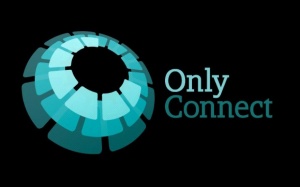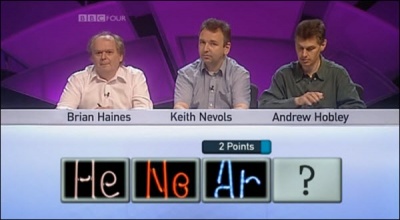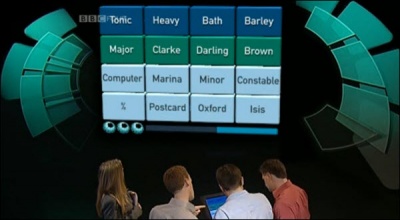Only Connect (2)
Andywatson (Talk | contribs) (→Synopsis) |
Andywatson (Talk | contribs) (→Synopsis) |
||
| Line 23: | Line 23: | ||
Two teams of three people vaguely connected by a job or hobby turn up to be ritually humiliated by some of the most - if not ''the'' most - difficult questions ever seen on a TV show on these shores, certainly outside a specialist subjects quiz. Clearly appealing to the widest demographic possible the show opens with, er, a string quartet and a flurry of Greek letters (or, in later series, Egyptian hieroglyphs), which will later adorn the game board. | Two teams of three people vaguely connected by a job or hobby turn up to be ritually humiliated by some of the most - if not ''the'' most - difficult questions ever seen on a TV show on these shores, certainly outside a specialist subjects quiz. Clearly appealing to the widest demographic possible the show opens with, er, a string quartet and a flurry of Greek letters (or, in later series, Egyptian hieroglyphs), which will later adorn the game board. | ||
| - | In the first round, the teams take it in turn to pick a Greek letter from the [[A Question of Sport|A Question of Sport]]-esque board whereupon the first of up to four clues are revealed. Further clues can be revealed but at a cost - 5, 3, 2, 1 points are earned after the 1st, 2nd, 3rd and final clue. The teams have 40 seconds to spot the connection, and the captain must buzz in during that time to offer a correct guess, otherwise their opponents get the opportunity to pick up a bonus point if they know the answer. The connections can range from the straightforward ("Card games") to the frankly bizarre ("People with palindromic surnames"), and it can take a few shows before you tune into the show's own mindset. There's also a set of picture clues and a set of musical ones (the latter indicated by a musical note), and Coren-Mitchell frequently (strongly) encourages the teams to sing tunes that have not been played, which is always entertaining. The Greek letters on the board later changed to Egyptian hieroglyphs, which are still in use to this day. Their positions on the board are: Top row, left to right: Two Reeds, Lion, Twisted Flax. Bottom row, left to right: Horned Viper, Water, Eye of Horus. | + | In the first round, the team that has won the toss decides whether they wish to go first and let the other team do so. The teams then take it in turn to pick a Greek letter from the [[A Question of Sport|A Question of Sport]]-esque board whereupon the first of up to four clues are revealed. Further clues can be revealed but at a cost - 5, 3, 2, 1 points are earned after the 1st, 2nd, 3rd and final clue. The teams have 40 seconds to spot the connection, and the captain must buzz in during that time to offer a correct guess, otherwise their opponents get the opportunity to pick up a bonus point if they know the answer. The connections can range from the straightforward ("Card games") to the frankly bizarre ("People with palindromic surnames"), and it can take a few shows before you tune into the show's own mindset. There's also a set of picture clues and a set of musical ones (the latter indicated by a musical note), and Coren-Mitchell frequently (strongly) encourages the teams to sing tunes that have not been played, which is always entertaining. The Greek letters on the board later changed to Egyptian hieroglyphs, which are still in use to this day. Their positions on the board are: Top row, left to right: Two Reeds, Lion, Twisted Flax. Bottom row, left to right: Horned Viper, Water, Eye of Horus. |
| - | In the second round, the clues form four terms of a sequence. The points are given for providing the fourth item in the sequence even if, as has happened in some cases, the team arrive at the right answer for completely the wrong reason. There's always a set of picture-clues in this round, and sometimes, but not necessarily, musical ones too. | + | In the second round, the clues form four terms of a sequence. The points are given for providing the fourth item in the sequence even if, as has happened in some cases, the team arrive at the right answer for completely the wrong reason. There's always a set of picture-clues in this round, and sometimes, but not necessarily, musical ones too. The team that went first in the previous round do so again in this one. |
<div class=image>[[Image:Onlyconnect sequence.jpg|400px]]''A little sample question - what completes this sequence?''</div> | <div class=image>[[Image:Onlyconnect sequence.jpg|400px]]''A little sample question - what completes this sequence?''</div> | ||
| - | Undoubtedly the most popular round is the Connecting Wall, where 16 clues have to be grouped together into four lots of four. The team to go first gets a choice between Lion and Water, the other team has to take the alternative hieroglyph. The team use a touch screen to stab in their guesses, and tactics come into play towards the end as the team only get three attempts to differentiate the last eight clues into the 3rd and 4th groups. One point is earned for each correct group found during the time, another point is earned for the correct reason behind the connection, and a bonus two points are added if all four groups and connections are given. The grid itself is cleverly programmed as a 3D virtual wall and works very well on screen. | + | Undoubtedly the most popular round is the Connecting Wall, where 16 clues have to be grouped together into four lots of four. The team to go first (always the one that went second in the previous two rounds) gets a choice between Lion and Water, the other team has to take the alternative hieroglyph. The team use a touch screen to stab in their guesses, and tactics come into play towards the end as the team only get three attempts to differentiate the last eight clues into the 3rd and 4th groups. One point is earned for each correct group found during the time, another point is earned for the correct reason behind the connection, and a bonus two points are added if all four groups and connections are given. The grid itself is cleverly programmed as a 3D virtual wall and works very well on screen. |
<div class=image>[[Image:Onlyconnect connectingwall.jpg|400px]]''The well esteemed Connecting Wall''</div> | <div class=image>[[Image:Onlyconnect connectingwall.jpg|400px]]''The well esteemed Connecting Wall''</div> | ||
Revision as of 01:34, 22 January 2017
Contents |
Host
Victoria Coren (credited as Victoria Coren Mitchell, 2013-)
Broadcast
Presentable for BBC Four, 15 September 2008 to 11 March 2013 (73 episodes in 6 series + 13 specials)
RDF Television and Parasol for BBC Four, 12 May 2013 to 7 July 2014 (39 episodes in 3 series + 2 specials)
RDF Television and Parasol for BBC Two, 1 September 2014 to present
Synopsis
Fresh from her hit documentary A History of Corners, Victoria Coren continues her career on that darkest recess of Britain's television corporation, BBC Four.
Two teams of three people vaguely connected by a job or hobby turn up to be ritually humiliated by some of the most - if not the most - difficult questions ever seen on a TV show on these shores, certainly outside a specialist subjects quiz. Clearly appealing to the widest demographic possible the show opens with, er, a string quartet and a flurry of Greek letters (or, in later series, Egyptian hieroglyphs), which will later adorn the game board.
In the first round, the team that has won the toss decides whether they wish to go first and let the other team do so. The teams then take it in turn to pick a Greek letter from the A Question of Sport-esque board whereupon the first of up to four clues are revealed. Further clues can be revealed but at a cost - 5, 3, 2, 1 points are earned after the 1st, 2nd, 3rd and final clue. The teams have 40 seconds to spot the connection, and the captain must buzz in during that time to offer a correct guess, otherwise their opponents get the opportunity to pick up a bonus point if they know the answer. The connections can range from the straightforward ("Card games") to the frankly bizarre ("People with palindromic surnames"), and it can take a few shows before you tune into the show's own mindset. There's also a set of picture clues and a set of musical ones (the latter indicated by a musical note), and Coren-Mitchell frequently (strongly) encourages the teams to sing tunes that have not been played, which is always entertaining. The Greek letters on the board later changed to Egyptian hieroglyphs, which are still in use to this day. Their positions on the board are: Top row, left to right: Two Reeds, Lion, Twisted Flax. Bottom row, left to right: Horned Viper, Water, Eye of Horus.
In the second round, the clues form four terms of a sequence. The points are given for providing the fourth item in the sequence even if, as has happened in some cases, the team arrive at the right answer for completely the wrong reason. There's always a set of picture-clues in this round, and sometimes, but not necessarily, musical ones too. The team that went first in the previous round do so again in this one.
Undoubtedly the most popular round is the Connecting Wall, where 16 clues have to be grouped together into four lots of four. The team to go first (always the one that went second in the previous two rounds) gets a choice between Lion and Water, the other team has to take the alternative hieroglyph. The team use a touch screen to stab in their guesses, and tactics come into play towards the end as the team only get three attempts to differentiate the last eight clues into the 3rd and 4th groups. One point is earned for each correct group found during the time, another point is earned for the correct reason behind the connection, and a bonus two points are added if all four groups and connections are given. The grid itself is cleverly programmed as a 3D virtual wall and works very well on screen.
The final word game, Missing Vowels, requires the contestants to buzz in when they can identify phrases, names or titles from which the vowels have been removed and the consonants respaced (e.g. THL NN GTWRFP S for THE LEANING TOWER OF PISA), appearing in batches of four connected clues. It doesn't particularly fit in with the rest of the show, but overall the rounds provide sufficient variety to hold up the interest.
Though not her first presenting role, it is La Coren's first quiz and surprisingly so, as she gets the hang of it rather quickly, keeping up the pace with a whip-cracking schoolmistressy charm while providing sufficient background from her notes to fully explain any loose ends. She certainly had more of the schoolmarm about her in earlier series, whereby she could come across as pretty severe; these days, she seems to have toned that down and, while she can still be on the strict side, she shows a good deal more of a sense of humour, which is very welcome.
It's not for everyone but those who like it, like it a lot. Enough people liked it for it to run ... and run ... and become a huge cult smash amongst young literate geeky types ... and bring a million viewers to BBC4 ... and eventually get a transfer to BBC Two. It's also worth noting that the show features many Mastermind and University Challenge alumni among the contestants.
Champions
2008 Crossworders (Mark Grant, David Stainer, Ian Bayley)
2009 Rugby Boys (Richard Parnell, Gary Dermody, Mark Labbett)
2010 (April) Gamblers (Jenny Ryan, Dave Bill, Alan Gibbs)
2010 (December) Epicureans (Katie Bramall-Stainer, David Brewis, Aaron Bell)
2011 Analysts (Paul Steeples, David Lea, William De Ath)
2012 Scribes (Dom Tait, Holly Pattenden, Gareth Price)
2013 (August) Francophiles (Ian Clark, Mark Walton, Sam Goodyear)
2013 (December) Board Gamers (Hywel Carver, Jamie Karran, Michael Wallace)
2014 Europhiles (Douglas Thomson, Khuram Rashid, Mark Seager)
2014-5 Orienteers (Paul Beecher, Sean Blanchflower, Simon Spiro)
2015-6 String Section (Tessa North, Richard Aubrey, Pete Sorrell)
Catchphrases
"...The teams have to find the connection between four apparently random clues..."
"...Please choose an Egyptian hieroglyph".
"What is the connection between these clues? Here's the first".
"Not it, either, I'm afraid..."
"Bad luck, your time's up and the wall's been frozen, but you can still get points for the connections between the groups that you didn't find..." (there are frequent variations on this phrase).
"And the bell's gone for the end of the quiz, so, looking at the final scores..."
Theme music
Dawson Sabatini
Trivia
Curiously, uses the same title - but is otherwise unconnected - as one of the most unpopular Radio 4 panel games in living memory. That version of Only Connect was helmed by Arabella Weir.
The title comes from the epigraph to E. M. Forster's 1910 novel Howards End.
Web links
Play the Connecting Wall from the comfort of your own computer




